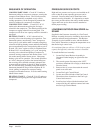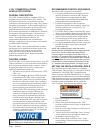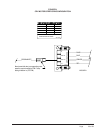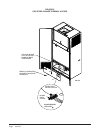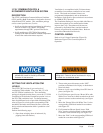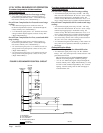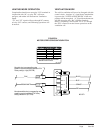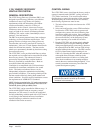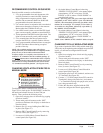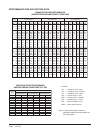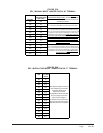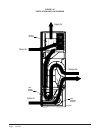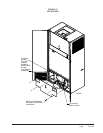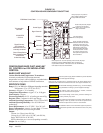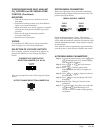
Manual 2100-549G
Page 40 of 59
I-TEC
ENERGY RECOVERY
VENTILATOR SYSTEM
GENERAL DESCRIPTION
The I-TEC Energy Recovery Ventilator (ERV) was
designed to provide energy efficient, cost effective
ventilation to meet I.A.Q (Indoor Air Quality)
requirements while still maintaining good indoor
comfort and humidity control for a variety of
applications such as schools, classrooms, lounges,
conference rooms and others. It provides a constant
supply of fresh air for control of airborne pollutants
including CO2, smoke, radon, formaldehyde, excess
moisture, virus and bacteria.
The ERV incorporates patented rotary heat exchanger
technology to remove both heat and moisture. The
package consists of unique rotary Energy Recovery
Cassettes that can be easily removed for cleaning or
maintenance. It has two 15-inch diameter heat transfer
wheels for efficient heat transfer. The heat transfer
wheels use a permanently bonded dry dessicant coating
for total heat recovery.
The I-TEC ERV is also provided with filters to reduce
the required service needed and to extend the life of the
heat recovery wheels. The exhaust air blower is
protected by disposable filters, and the intake air
blower is protected by washable filters. Both are
accessible without the need for tools.
Ventilation is accomplished with (2) blower/motor
assemblies for maximum ventilation at low sound
levels. The intake and exhaust blowers can be
independently adjusted to maintain desired building
pressurization conditions. The rotating wheels provide
the heat transfer effectively during both summer and
winter conditions. Provides required ventilation to meet
the requirements of ASHRAE 62.1 Standard.
NOTE: During operation below 5°F outdoor temperature,
freezing of moisture in the heat transfer wheel can occur.
Consult the factory if this possibility exists.
The I-TEC ERV can be controlled in different ways. It
can be turned ON/OFF with an occupancy control,
thermostat, or CO2 control. It can also be configured
for fully-modulating variable speed with a CO2 control
to only bring in the minimal amount of ventilation
required (helping to minimize sound levels and
ventilation load on the structure).
CONTROL WIRING
The I-TEC ERV comes wired from the factory ready to
operate in manual mode (ON/OFF cycling) and set to
375 CFM of ventilation. Care must be taken when
deciding how to control the operation of the ventilator.
When designing the control circuit for the ventilator,
the following requirements must be met.
1.
The indoor blower must be run whenever the I-TEC
ERV is run.
2. Select and configure the correct CFM ventilation
level that the I-TEC ERV needs to operate and
configure the system to this level following later
instructions within this section. Over ventilating
serves no useful purpose and significantly affects
the overall efficiency of the heat pump system.
System operating costs would also increase.
3. Run the I-TEC ERV only during periods when the
conditioned space is occupied. Running the ERV
during unoccupied periods wastes energy, decreases
the expected life of the ERV, and can result in large
moisture buildup in the structure. The ERV removes
60-70% of the moisture in the incoming air, not
100% of it. Running the ERV when the structure is
unoccupied allows moisture to build up in the
structure because there is little or no cooling load.
Thus, the air conditioner is not running enough to
remove the excess moisture being brought in. Use a
control system that in some way can control the
system based upon occupancy.
Operating the
I-TEC
ERV during unoccupied
periods can result in a build up of excess
moisture in the structure.



